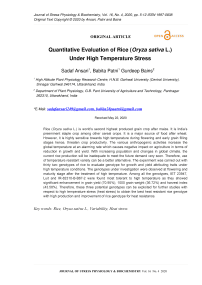Quantitative Evaluation of Rice (Oryza sativa L.) Under High Temperature Stress
Автор: Sadaf Ansari, Babita Patni, Gurdeep Bains
Журнал: Журнал стресс-физиологии и биохимии @jspb
Статья в выпуске: 4 т.16, 2020 года.
Бесплатный доступ
Rice (Oryza sativa L.) is world’s second highest produced grain crop after maize. It is India’s preeminent staple crop among other cereal crops. It is a major source of food after wheat. However, it is highly sensitive towards high temperature during flowering and early grain filling stages hence, threaten crop productivity. The various anthropogenic activities increase the global temperature at an alarming rate which causes negative impact on agriculture in terms of reduction in growth and yield. With increasing population and changes in global climate, the current rice production will be inadequate to meet the future demand very soon. Therefore, use of temperature resistant variety can be a better alternative. The experiment was carried out with thirty two genotypes of rice to evaluate genotype for growth and yield attributing traits under high temperature conditions. The genotypes under investigation were observed at flowering and maturity stage after the treatment of high temperature. Among all the genotypes, IET 23947, Luit and IR-82310-B-B67-2 were found most tolerant to high temperature as they showed significant enhancement in grain yield (70.95%), 1000 grain weight (36.72%) and harvest index (43.58%). Therefore, these three potential genotypes can be exploited for further studies with respect to high temperature stress (heat stress) to obtain the best heat resistant rice genotype with high production and improvement of rice genotype for heat resistance.
Rice, Oryza sativa L., Variability, Heat stress
Короткий адрес: https://sciup.org/143173855
IDR: 143173855
Текст научной статьи Quantitative Evaluation of Rice (Oryza sativa L.) Under High Temperature Stress
The average world temperature is increasing by 0.3oC per decade due to different biotic and abiotic factors, this result in heat stress among crops during heat sensitive stages and adversely affects the yield. Climate change has increased the intensity of heat stress which results in serious economic losses of agricultural and horticultural crops (Olesen et al., 2011). Rice (Oryza sativa L.) is one of the major staple food crops and feeds half of the world’s population with 27% of dietary energy, 20% of dietary carbohydrate in the developing world and also provides 21% and 15% of global human per capita energy and protein respectively ( ujita et al, 2013). This crop is cultivated under diverse conditions and production systems but, the changing climate is becoming a serious hazard for rice. Heat stress tolerance in different growth phases of rice is a complex phenomenon affecting morphological and yield responses. Morphological, physiological and biochemical changes in plants affect growth and development resulting in yield alteration. The different growth stages are temperature dependent from seed germination to flowering that cause thermal injury or death of the seed (Lavania et al., 2015). The high temperature cause spikelet sterility which decreases grain weight reduces grain filling and increases percentage of white chalky grains and also decreases grain size and amylose content therefore, affecting grain quality of rice (Ishimaru et al., 2009). The different morpho-physiological characters (i.e. photosynthetic rate, respiration, water relations) are affected with increase in temperature such as plant biomass is reduced due to decrease in photosynthesis by the deactivation of RuBisCO and increased transpiration and stomatal conductance (Carmo-salvia et al., 2012). Heat stress has harmful impacts on plant growth, metabolism, developmental processes and production
(Hasanuzzaman et al. , 2013).
MATERIALS AND METHODS
The present experiment was conducted at Norman E. Borloug Crop Research Centre of the G.B. Pant University of Agriculture and Technology, Pantnagar, U. S. Nagar, Uttarakhand, during Kharif season of 2016 to appraise the effect of high temperature stress on growth, development and yield of thirty two genotypes of rice. The geographical distribution of Pantnagar lies in Tarai belt at an altitude of 243.8m asl. The seeds were procured from Indian Institute of Rice Research (IIRR), Hyderabad. The seedling were grown and transplanted in complete randomized block design in two different rows (Control vs Treatment) with uniform spacing, having 32 entries (namely, IET 24053, IET 24705, IET 24796, IET24040, Gontra Bidhan-3(NC), IET 24798, IET 24708, US 314 (HC), Sahbhagidhan, IET 24797, IET 23356, IET 23947, NH-210, NH-219, NH-363, 142(S), 175-2 (K), S-458, 377-24, DRR Dhan-43, NDR-97, Luit, PR-124, Somali, GQ-25, IR-82635-B-B-47-1, MRC-603-383, IR-55178, SG-26-120, IR-82310-B-B67-2, IET 23354 and IET 23996) with 3 replications including 15 plants each with spacing of 20cm x 10cm, having total plot area of 283.5 m2. All the cultural practices were followed as recommended. During the experiment different phenological and morphological characters were observed and recorded for evaluation.
RESULTS
During the experiment different morphological traits among the rice genotypes were recorded at flowering and maturity stage. The maximum increase in total dry matter (TDM) (gm-2) was recorded in Luit (62.48%) whereas maximum decrease was observed in NH-219 (56.79%) under high temperature stress as compared to control at flowering stage, similarly the maximum increase in TDM (gm-2) was observed in MRC-603-383 (74.19 %) and maximum decrease in DRR Dhan-43 (52.86%) under high temperature stress as compared to control at maturity stage. It was statistically significant for treatment (T), genotypes (G) as well as for T x G interaction at flowering and maturity stage. Duration of green leaves and leaf area vary due to genotypic difference. Some genotypes showed increased TDM due to increase in photosynthetic rate and accumulation of photosynthates. Under high temperature stress, during early growth stages, tillering, leaf expansion and nutrient uptake are high, which shows the positive effects on biomass production (Parvin, 2016) but, in later stages biomass reduces due to larger burden of increased maintenance respiration associated with excessive growth, faster senescence and shortened growth period (Korner, 2012). The dry matter production can be increased with the rise in temperature due to increase in CO2 concentration, which decreases stomatal conductance and increases water use efficiency through regulation in transpiration process and photorespiration which ultimately promotes photosynthetic capacity (Ishimaru et al., 2014).
The leaf area index (LAI) was observed to have maximum increase in Luit (112.04 %) and maximum decrease in NH-219 (36.86 %) under high temperature stress as compared to control at flowering stage. It was statistically significant for treatment (T), genotypes (G) as well as for T X G interaction at flowering stage. Rise in temperature adversely affects the photosynthetic rate and also decreases stomatal conductance due to accumulation of high CO 2 level (Shah & Paulsen, 2003). At the end of tillering stage, high temperature stress strongly reduces photosynthesis rate by 50-60% in wheat. Reduction in photosynthesis with high temperature was observed by reduced LAI. Initiation and expansion of roots, leaves, shoots, tillers, branches and reproductive organs are strongly driven by high temperature (Chakrabarti et al , 2013 . A warmer condition leads to acceleration in organ initiation rate and shorter duration of organ growth (Prasad et al. , 2008 .
The maximum increase in 1000 grain weight (g) after harvesting of seeds was recorded in Luit (36.21 %) and maximum decrease in SG-26-120 (38.72 %) under high temperature stress as compared to control. It was statistically significant for treatment (T), genotypes (G) as well as for T X G interaction.
The grain yield (gm-2) was recorded to increase in IR-82310-B B67-2 (70.95%) and maximum decrease in NH-363 (52.52%) as compared to control at maturity. It was statistically significant for treatment (T), genotypes (G) as well as for T X G interaction.
The grain yield was affected by high temperature (35oC) at the flowering stage and also during the ripening period (Morita et al., 2005). During grain filling phase, the yield reduces due to spikelet sterility and shortening of the time period of grain filling phase (Tian et al., 2009). Delay in sowing and heat stress in grain filling stage also reduces biological yield and decrease in final grain weight by reduction in grain growth rate in early and middle stages of grain filling (Islam, 2011). In post-anthesis process high temperature stress in wheat is a major cause of reducing yield due to the loss of viable leaf area and a reduction in the duration of green leaves, ultimately causing reduction in grain yield, similar to present findings. It was also observed that increase in duration of green leaves had a positive effect on grain yield under high temperature stress. Leaf area of wheat largely depends on the diversity of the genotype, plant growth stage and air temperature (Vijayalakshmi and Sangeetha, 2011).
Decrease in spikelet sterility (61%), grain length (2%), grain width (2%) and grain weight results in decreased grain yield about 90% at high night temperature (Mohammed & Tarpley, 2010) . The grains ripened under day and night high temperature shows a reduction in grain weight during meiosis (Li et al. 2011) . 1000 grain weight can be determined by the development of hull and endosperm. Abnormal development of spikelet’s showing lessened hull size and grain weight due to effect of high temperature (Matsui et al. , 2001) . The grain filling stage shows more serious influence than the flowering stage on 1000 grain weight at elevated temperature (Yun-Ying et al. , 2008) .
The highest increment in harvest index (%) was recorded in IR-82310-B-B67-2 (43.58%) and highest decline in NH-363 (64.19%) as compared to control condition. It was statistically significant for treatment (T), genotypes (G) as well as for T X G interaction. High temperature was found to accelerate rice development but reduce grain yield because there is less time for radiation to be intercepted during the vegetative growth phase (Teixeira et al., 2013). Poor grain development and diversion of nutrients from vegetative shoot to panicle may possibly be one of the reasons for poor harvest index in plants subjected to high temperature. The reduction in grain yield was mainly attributed to a marked decline in the number of grains per panicle owing to enhancement in spikelet sterility (Gadakh, 2013). The photosynthates might have exhausted rapidly due to high respiration rate. So, the biomass accumulation might have reduced remarkably. The reduction in biological yield by high thermal stress (38oC) was mainly due to a marked reduction in grain yield, as the vegetative mass (leaf and stem mass) was not much affected by heat stress. The higher night temperature can increase the dark respiration of plants and thus diminish net biomass production (Han et al., 2013).
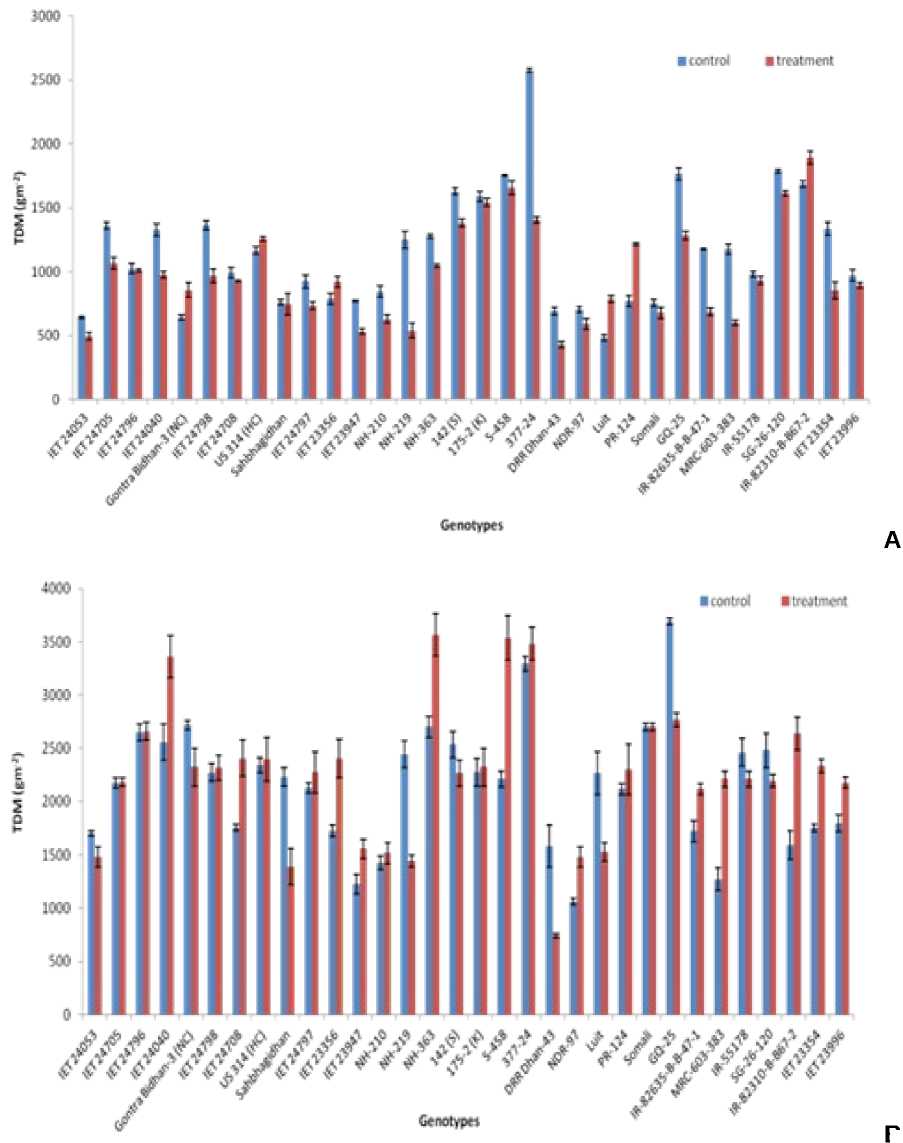
B
Figure 1 (A) Graph indicating the effect of high temperature stress on TDM (gm-2) at flowering and (B) TDM (gm-2) at maturity.
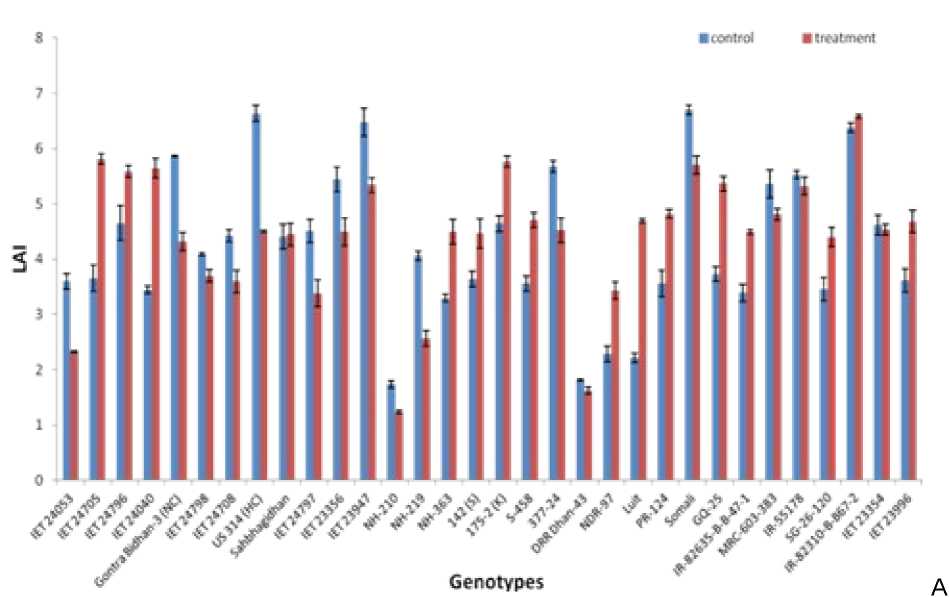
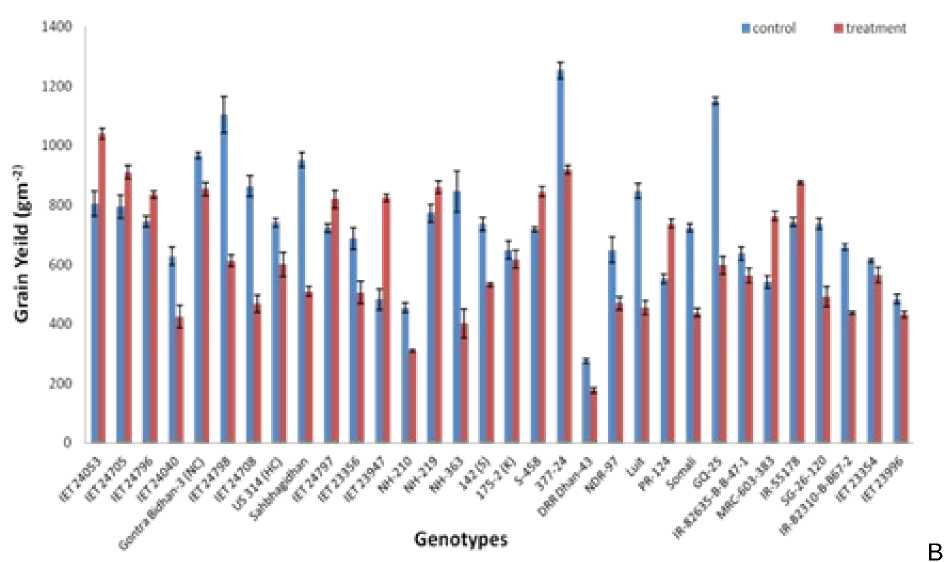
Figure 2 Graph (A) indicating effect of high temperature stress on LAI at flowering (B) representing grain yield (gm-2) at maturity.
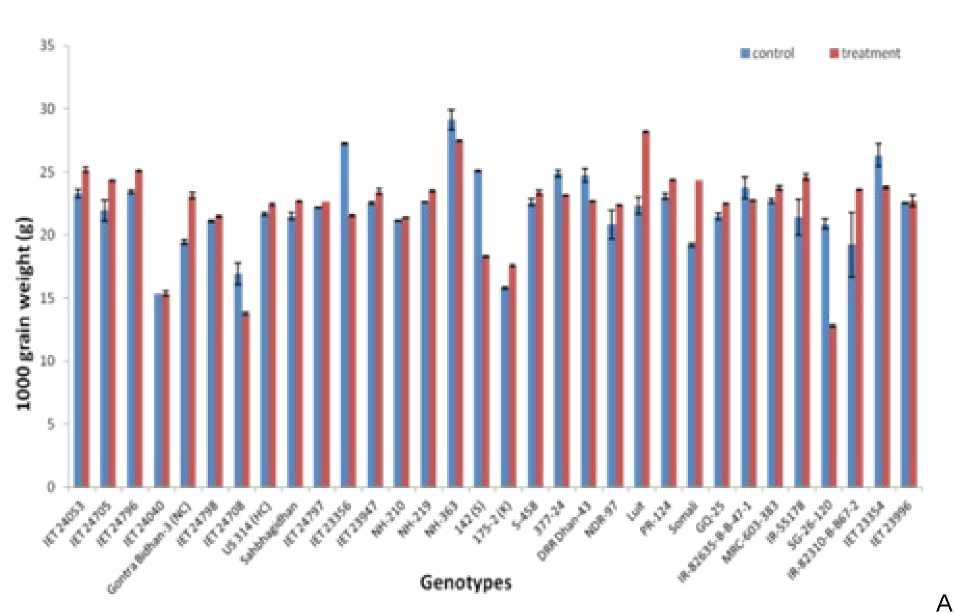
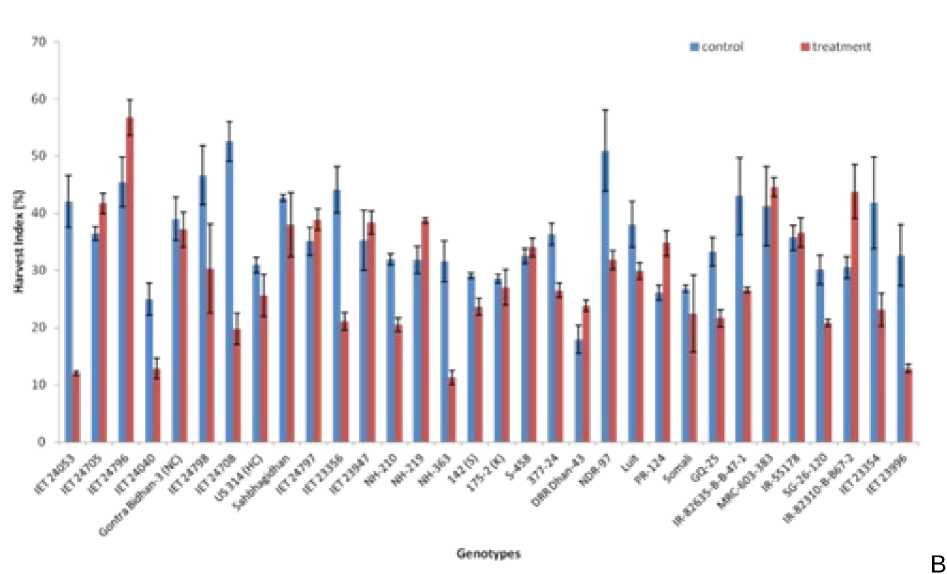
Figure 3 Graph depicting (A) the effect of high temperature stress on 1000 grain weight (g) and (B) harvest index (%) at flowering.
SUMMARY AND CONCLUSION
Genotype IET 24705, IET 24796, IET 24797, NH-219, S-458, PR-124, MRC-603-383, IET 23947, IR-
55178, Luit and IR-82310-B-B67-2 have highest 1000 grain weight, harvest index and grain yield under the raised temperature. lowering at cooler time of day, more pollen viability, larger anthers, longer basal dehiscence and presence of long basal pores are some of the phenotypic markers for high temperature tolerant allowing avoidance of peak stress periods. Varieties having highest magnitude of yield attributing characters and phenotypic markers will be useful for the selection of genotype for high temperature conditions. The above heat tolerant rice genotype should be explored further for biochemical qualitative and quantitative study as well as molecular work should be analysed for the better yield production and improvement of rice.
ACKNOWLEDGEMENT
Список литературы Quantitative Evaluation of Rice (Oryza sativa L.) Under High Temperature Stress
- Carmo-Silva, A. E., Gore, M. A., Andrade-Sanchez, P., French, A. N., Hunsaker, D. J., & Salvucci, M. E. (2012). Decreased CO2 availability and inactivation of Rubisco limit photosynthesis in cotton plants under heat and drought stress in the field. Environmental and Experimental Botany, 83, 1-11.
- Chakrabarti, B., Singh, S. D., Kumar, V., Harit, R. C., & Misra, S. (2013). Growth and yield response of wheat and chickpea crops under high temperature. Indian Journal of Plant Physiology, 18(1), 7-14.
- FAOStat, F. (2010). Agriculture Organization. Rome, Italy: http://faostat. External. fao. org/. Accessed on 17th April.
- Fujita, D., Trijatmiko, K. R., Tagle, A. G., Sapasap, M. V., Koide, Y., Sasaki, K., & Fukuta, Y. (2013). NAL1 allele from a rice landrace greatly increases yield in modern indica cultivars. Proceedings of the National Academy of Sciences, 110(51), 20431-20436.
- Gadakh, S. R. (2013). Physio-biochemical studies in sorghum under water stress. Thesis, Doctor of Philosophy. MPKV, University Library.
- Han, F., Wang, W., Li, Y., Shen, G., Wan, M., & Wang, J. (2013). Changes of biomass, lipid content and fatty acids composition under a light–dark cyclic culture of Chlorella pyrenoidosa in response to different temperature. Bioresource technology, 132, 182-189.
- Hasanuzzaman, M., Nahar, K., Alam, M. M., Roychowdhury, R., & Fujita, M. (2013). Physiological, biochemical, and molecular mechanisms of heat stress tolerance in plants. International Journal of Molecular Sciences, 14(5), 9643-9684.
- Ishikawa, S., Ando, S., & Yoshikawa, S. (2014). Effects of Planting Sugarcane and Napier Grass on N Leaching from Lysimeters under High Application of Cattle Manure. American Journal of Experimental Agriculture, 4(5), 497.
- Ishimaru, T., Horigane, A. K., Ida, M., Iwasawa, N., Sanoh, Y. A., Nakazono, M., & Yoshida, M. (2009). Formation of grain chalkiness and changes in water distribution in developing rice caryopses grown under high-temperature stress. Journal of Cereal Science, 50(2), 166-174.
- Islam, M. T. (2011). Effect of temperature on photosynthesis, yield attributes and yields of aromatic rice genotypes. International Journal of Sustainable Crop Production, 6(1), 14-16.
- Körner, C. (2012). Water, nutrient and carbon relations. In Alpine Treelines 151-168.
- Springer Basel. Lavania, D., Dhingra, A., Siddiqui, M. H., Al-Whaibi, M. H., & Grover, A. (2015). Current status of the production of high temperature tolerant transgenic crops for cultivation in warmer climates. Plant Physiology and Biochemistry, 86, 100-108.
- Li, H., Chen, Z., Hu, M., Wang, Z., Hua, H., Yin, C., & Zeng, H. (2011). Different effects of night versus day high temperature on rice quality and accumulation profiling of rice grain proteins during grain filling. Plant Cell Reports, 30(9), 1641-1659.
- Matsui, T., Omasa, K., & Horie, T. (2001). The difference in sterility due to high temperatures during the flowering period among japonica-rice varieties. Plant Production Science, 4(2), 90-93.
- Mohammed, A. R. & Tarpley, L. (2010). Effects of high night temperature and spikelet position on yield-related parameters of rice (Oryza sativa L.) plants. European Journal of Agronomy, 33(2), 117-123.
- Morita, S., Hattori, T., Inanaga, S., Araki, H., An, P., Luxová, M., & Lux, A. (2005). Application of silicon enhanced drought tolerance in Sorghum bicolor. Physiologia Plantarum, 123(4), 459-466.
- Olesen, J. E., Trnka, M., Kersebaum, K. C., Skjelvåg, A. O., Seguin, B., Peltonen-Sainio, P., & Micale, F. (2011). Impacts and adaptation of European crop production systems to climate change. European Journal of Agronomy, 34(2), 96-112.
- Parvin, K. (2016). Mitigation of salt stress in tomato by exogenous application of calcium. Thesis, Doctor of Philosophy. Umm Al Qura University, Makkah Al Mukaramah, K.S.A.
- Piao, S., Ciais, P., Huang, Y., Shen, Z., Peng, S., Li, J., & Friedlingstein, P. (2010). The impacts of climate change on water resources and agriculture in China. Nature, 467(7311), 43.
- Prasad, P. V .V., Staggenborg, S. A., & Ristic, Z. (2008). Impacts of drought and/or heat stress on physiological, developmental, growth, and yield processes of crop plants. In: Response of crops to limited water: Understanding and modeling water stress effects on plant growth processes Volume 1 Eds: L.R. Ahuja, V.R. Reddy, S.A. Saseendran, Qiang Yu, p. 301-355.
- Shah, N. H., & Paulsen, G. M. (2003). Interaction of drought and high temperature on photosynthesis and grain-filling of wheat. Plant and Soil, 257(1), 219-226.
- Teixeira, E. I., Fischer, G., van Velthuizen, H., Walter, C., & Ewert, F. (2013). Global hot-spots of heat stress on agricultural crops due to climate change. Agricultural and Forest Meteorology 170, 206-215.
- Tian, F., Li, B., Ji, B., Yang, J., Zhang, G., Chen, Y., & Luo, Y. (2009). Antioxidant and antimicrobial activities of consecutive extracts from Galla chinensis: The polarity affects the bioactivities. Food Chemistry, 113(1), 173-179.
- Vijayalakshmi, K., & Sangeetha, I. (2011). Determination of bioactive components of ethyl acetate fraction of Punica granatum Rind extract Inl. Journal of Pharmacutical Science Drug Response, 3 (2), 116-122.
- Yun-Ying, C. A. O., Hua, D., Li-Nian, Yang, Zhi-Qing, Wang, Shao-Chuan, Zhou, & Jian-Chang, Yang. (2008). Effect of heat stress during meiosis on grain yield of rice cultivars differing in heat tolerance and its physiological mechanism. Acta Agronomica Sinica, 34(12), 2134-2142.

